ESP VOLKSWAGEN GOLF 2008 Owner's Manual
[x] Cancel search | Manufacturer: VOLKSWAGEN, Model Year: 2008, Model line: GOLF, Model: VOLKSWAGEN GOLF 2008Pages: 444, PDF Size: 92.7 MB
Page 232 of 444
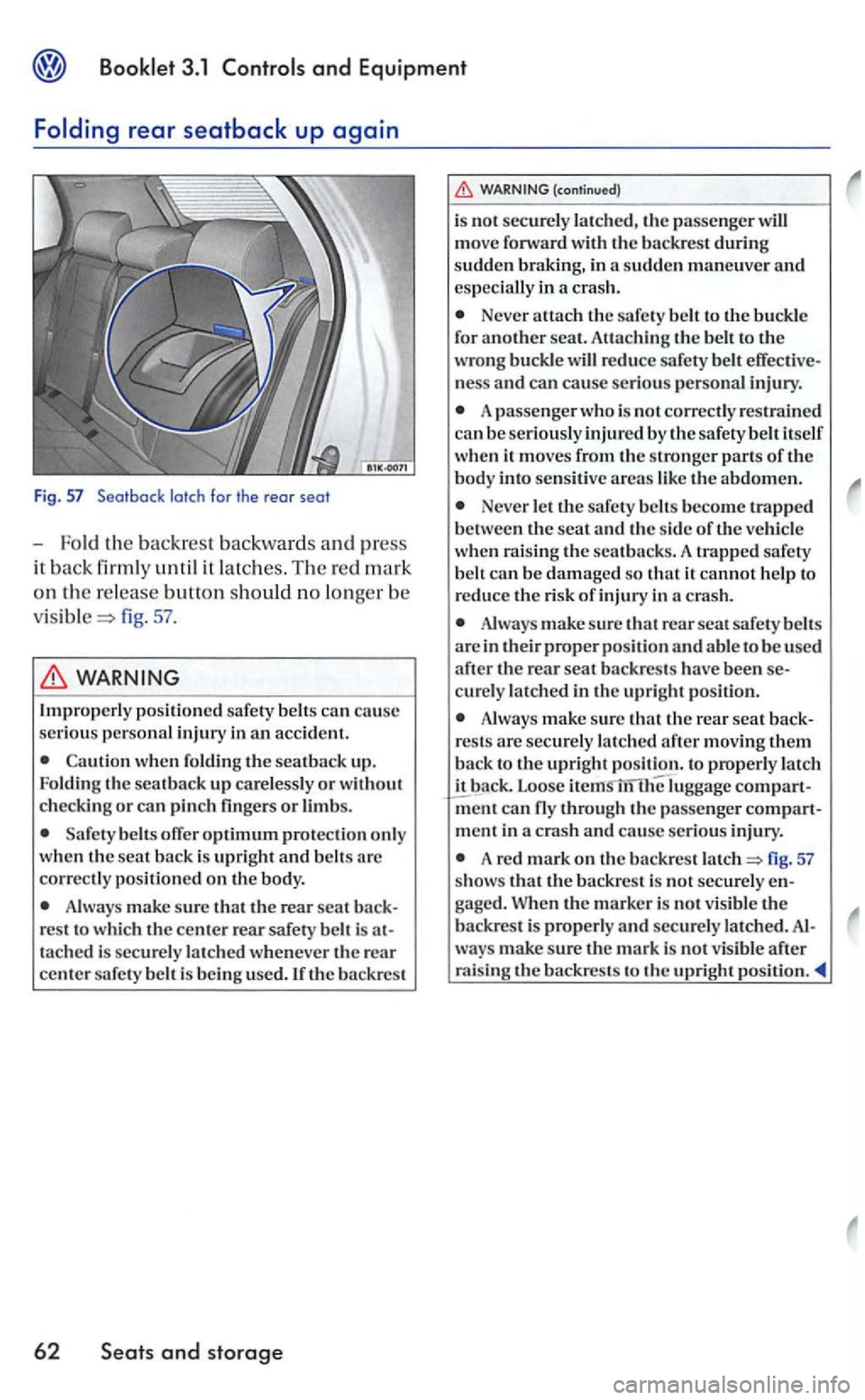
and Equipment
the backrest backwards and press
it back firmly until it latches. The re d mark
o n rhe release button should no lo nge r be
fig. 57 .
when foldin g the seat back up.
Folding the seat back up care lessly or without
c h ecki ng or ca n pin ch fin gers or limbs.
belts offer optimum protection only
w hen the sea t back is upri ght and belts arc
correc tly po sitioned on th e body.
Always make sure that the rear seat res t to whic h th e cente r rear safety belt is t ached is securely la tched whenever the rear center sa fety be lt is use d. If the backrest
62 Seats and storage
(con tinued)
is not secu re ly latched, the passenger move forward with the backrest during
sudde n braking , in a sudden maneuve r and espec ially in a c rash.
Never attach th e safe ty belt to the buckle
for another seat. Attaching the belt to the wro ng buckle ness and can cause serious pe rso nal injury.
A passenger who is not correctly restrain ed
ca n b e se riousl y injured by th e sa fety belt itself
when it move s the strong er parts of the body into sensitiv e areas like the abdomen.
Never le t th e safety belts beco me trapped
between the seat and the side of th e veh icle
when rai s in g the sea t ba cks. A trapped safety
b elt can be damaged so that it cannot help to
r e du ce the risk of injury in a crash.
Always make sure th at rear seat safety belts are in their proper position and able to be used
after the rear seat b ackres ts have been
Always make sure that the rear seat rests are sec urely latched after moving th em
b ack to the upright position. to properly latc h
it bac k. Loose
m ent in a crash and cause se rious injury .
A re d mark on the ba ckrest fig. 57 show s that the ba ckres t is not securely gaged. When the m arker is not visible the backrest is properly and sec urely latch ed. ways m ake sure the mark is not visibl e after raising the backre sts to the upright
Page 236 of 444
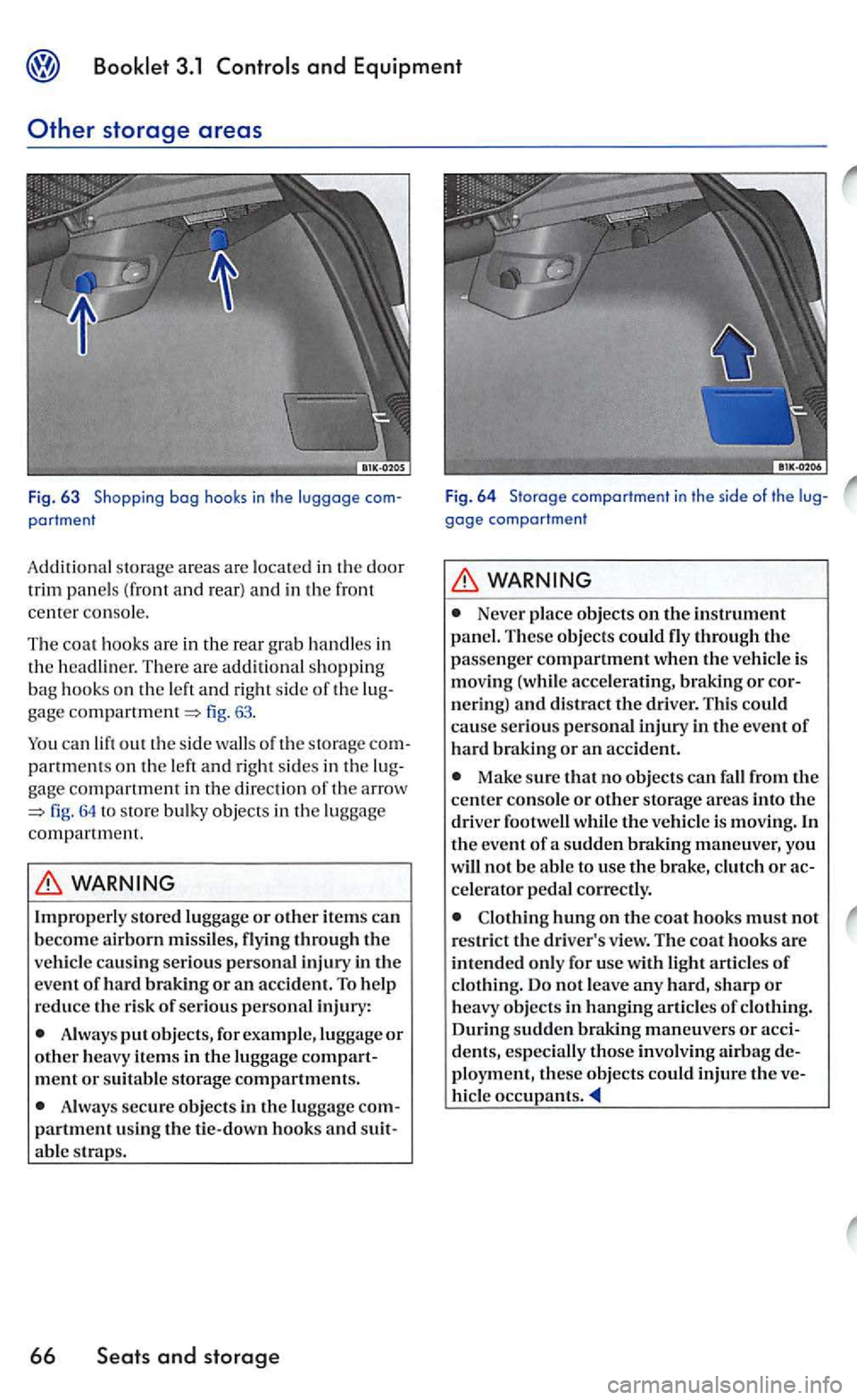
and Equipment
Other storage areas
Fig. 63 Shopping bog hooks in the luggage portment
Additiona l s torage areas are located in the door
trim panel s (f ront and rear ) and in the front
center console.
The coat hooks are
in the rear grab hand le s in th e There are add itional shopping
bag hook s on the and right side of the fig. 63.
out the s ide of the storage partm ent s on the and right sides in the
fig. 64 store bulky objects in the luggage
com partm ent.
Always put objects, for example, lug gage or other heavy items in the luggag e compartment or suitabl e storage compartments.
Always secure objects in the lu ggage partment using the tie-down hooks and able straps.
66
gage comportment
Never place objects on the instrument
panel. These objects could fly through the
passeng er compartm ent when th e is mov ing (w hile acce lerating, braking or n ering) and
Make sure that no objects fall from the cente r console o r other sto rage areas into the
dri ver footwell while the is m ov ing. In the event of a sudden brakin g maneuver, you
w ill not be able to usc tl1e brake,
hung on tl1e coat hooks must not rest rict the dri ver's view . The coat hooks arc intended only for usc with light of
of During sudden braking maneuvers or acci-
d e nts, especially those inv olv in g airbag de
ployment , these objects could inj ure the ve-occupants.
Page 244 of 444
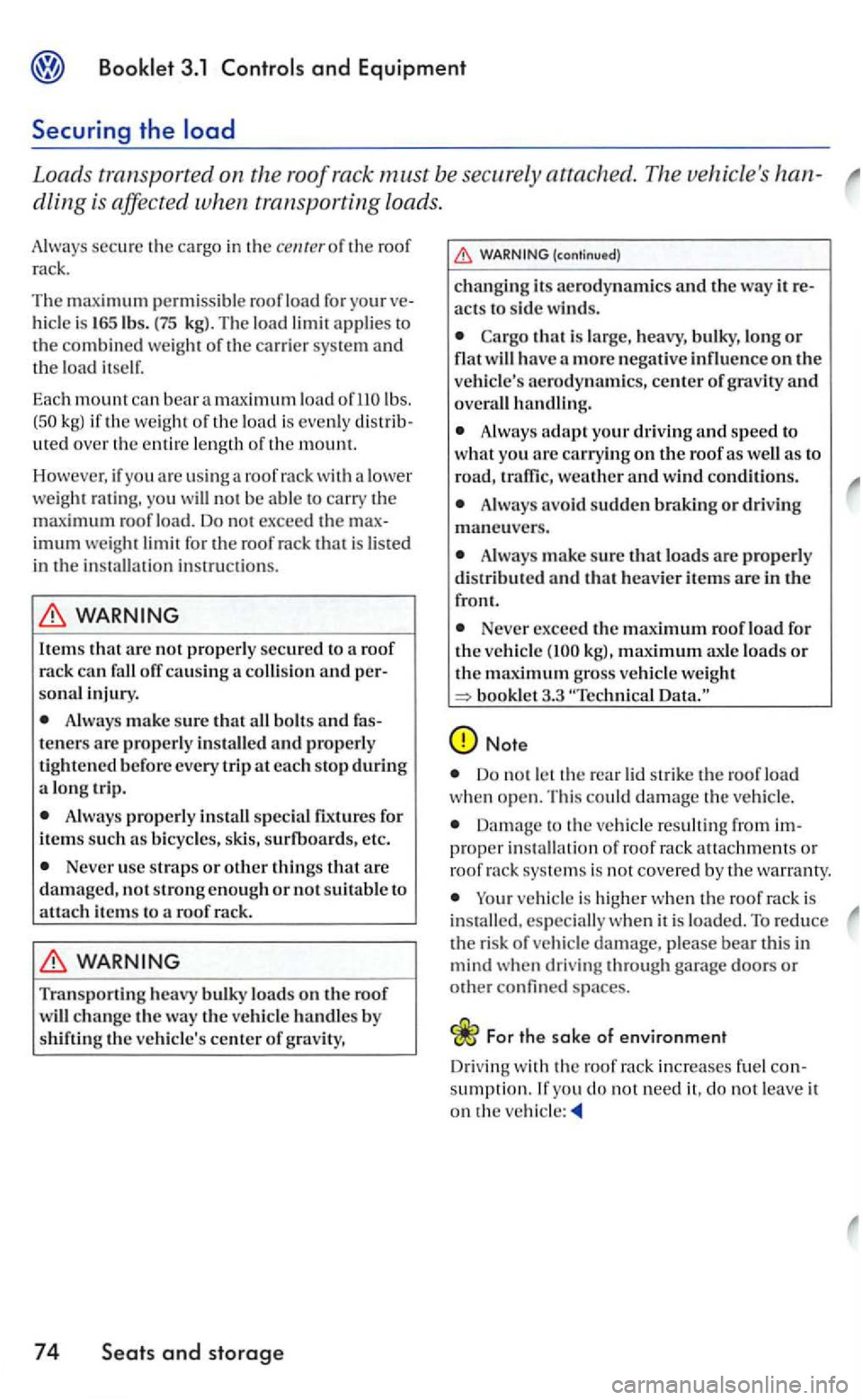
Booklet 3.1 Control s and Equipment
Securing the
Loads transported on the roof rack must be attached. The vehicle's han
dling is affec ted when transporting loads .
Always secure the cargo in th e center of the roof
rack.
Th e maximum permi
ssibl e roof load for your ve
hicle is 165 lb s. (75 kg). The load limit applies to th e combined weig ht of the carrier sys te m a nd
t h e load itse lf.
Each m ou nt can bea r a max im um loa d lbs.
imum weig ht limit for the roof rack
causing
A lw ays make sure that all and fas
t e n ers are pro perl y in stalle d and properl y
ti ght en ed befo re eve ry trip at e ac h sto p during
a long trip.
A lw ays properl y install s p ecial fixtures fo r items su ch a s bi cy cles, skis, surfboard s, etc.
Never use straps o r other things that are
d am age d, not stro n g e nough or n ot s uit able to
a tt ac h item s to a roof rack .
Transporting heavy bulky loads on the roo f
will change the way the ve hicle handles by
s hifting th e ve hicle's center or grav ity,
74 and storage
WARNING (continued )
changing its aerodynamics and th e way it reacts to sid e winds.
th at i s large, heavy , b ulky, lo n g or
Alw ays adapt your drivin g and sp eed to
w ha t yo u a rc carrying on th e roof as as to
road, t raffic, weath er a nd wind conditi ons.
Alwa ys avoid sudden brakin g or driving maneu ve rs .
A lwa ys make sure that loads arc p roperl y
dis tr ibuted and tha t heavier items are in the fro nt .
Never exceed th e maximum roofload for th e ve hicle kg). maximum axle loads or th e maximum gross vehic le weig ht booklet3.3
Note
Do n ot le t the rear lid strike the roof load
w hen open . This co uld damage the vehicle .
Damage to the vehicle resulting from im-
proper i n stallation o r roof rack attachments or
roof rack syste ms is no t covered b y th e warranty.
Your ve hicle is hig her when th e roof rack is
i n stalled, especially when it is loaded. To reduce the ris k or ve hicle damage, please bea r this in
min d when driv ing through garage doors or o ther confined spaces .
For the sa ke of envir o nment
Driv ing w ith
the roof rack increases fu e l consumption. you do not n eed it, do not leave it on the
Page 260 of 444
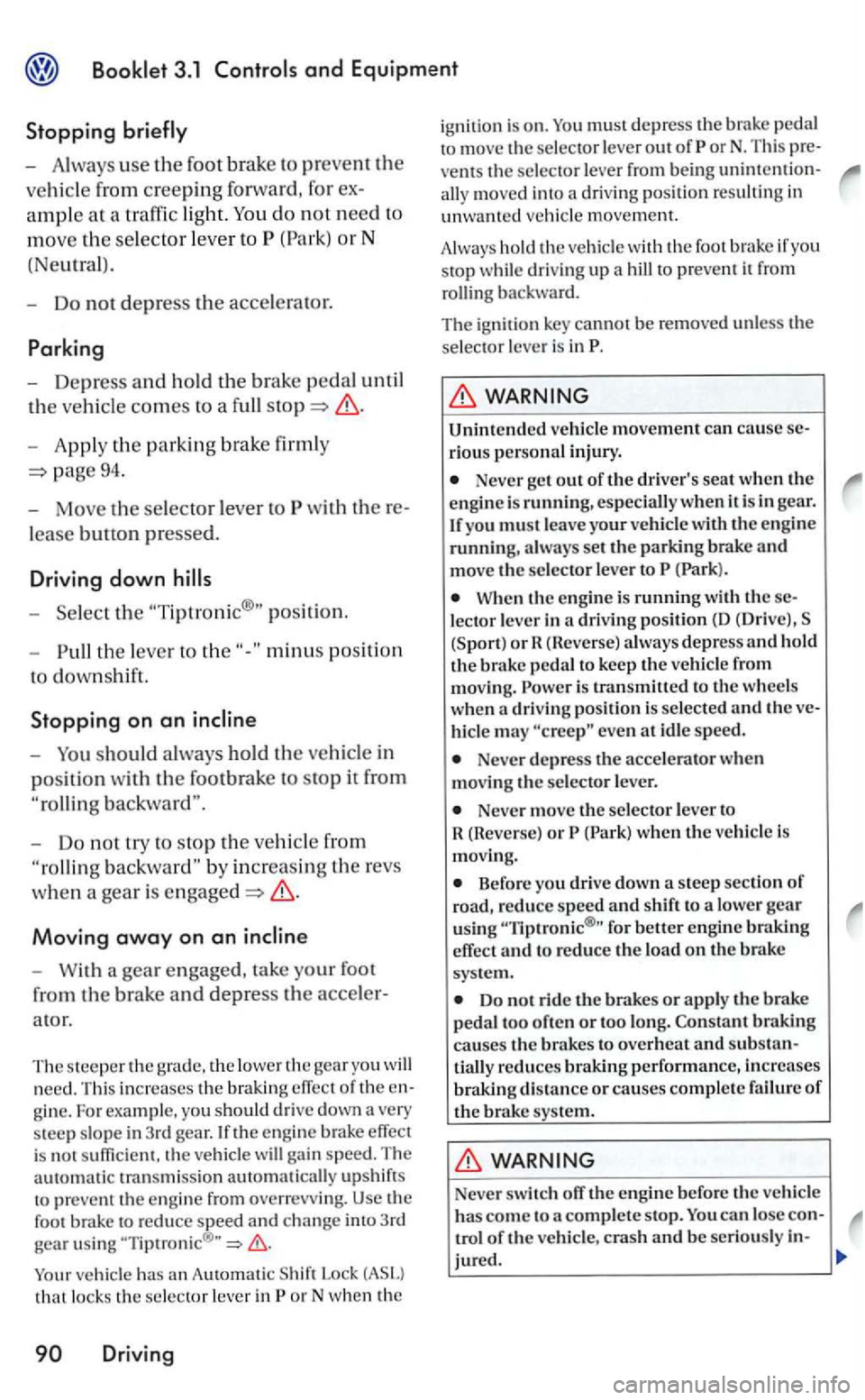
and Equipment
Stopping
-Alw ays use the foot brake to prevent the
vehicle from creeping forward , for
do not need to
move the selector leve r to (Park) or N
(Ne
utra l).
- Do not depress the accele rator.
Parking
- Depress and hold the brake pedal until
the vehicl e comes to a
- App ly the parking brake firmly
94.
- Mo ve th e
selector lever with
lease butto n pressed.
Driving dow n
-the position.
-
the lever to
-
- Do not try to stop the veh icle from
by increa sing the revs
w hen a
gear is
Moving a way on an
- W ith a gear engaged, tak e your foo t
f r o m
the brake and depress the
ator.
Th e stee per the grade, the lower the you will need. This increases the brakin g gine. For examp le, yo u sh ould drive down a very
s teep slop e in 3rd gear.lfthe engine brake is not s uffi cient. the vehicl e will gain spe ed . Th e tran smis sion automati cally up shift s
t o preve nt the engin e from the
foot brake to reduce speed and ch a nge into 3rd gear usin g 'Tiptronic®"
vehicl e has Automatic Sh if t Loc k (ASI.l that locks the selec tor lever in
must depre ss the brake pedal
t o move the selec tor lever out or N. Thi s
ally moved into a driving positi on result ing in unwante d ve hicle movement.
A lw a
ys ho ld th e vehicle with the foot if you
s top while driv in g up a hill to preve nt it fro m
rollin g backwa rd.
T he ig niti on
key ca nnot be remo ved unless the
s el ec tor lever is in
rious personal injury .
Never get out of the dri ver's seat when th e engin e is running, especially when it is in gear. If yo u must leave your vehicl e with the engine running, always set the parking brake and move the se lec tor lever (Pa rk).
When the engine is running with (Dri ve). (Sport) orR (Ileve rse ) a lways depress hold the brake pedal to keep th e ve hicl e from
m ov ing. is trans m i!!ed to the w heels
w hen a driving pos ition is selected even at idle speed.
Never depress th e accelerator when moving the selecto r lever.
Never move the selector lever to
R (Reverse) or whe n the vehicle is
m ov ing.
Before you drive down a steep section of road, reduce speed and shift to a low er gear usin g for better engin e braking effect and to reduce the load on the brake
sys te m.
Do not rid e the brakes or apply the brake pedal too often or too long. Constant braking
causes the brakes to overheat and tially reduces braking performance, increases braking dis tance or causes complete failu re of
the brake sys tem.
Never switch ofT the engine before the vehicle
h as come to complete s top. ca n lose con-trol of the ve hicle , crash and be serious ly in -
jured.
Page 264 of 444
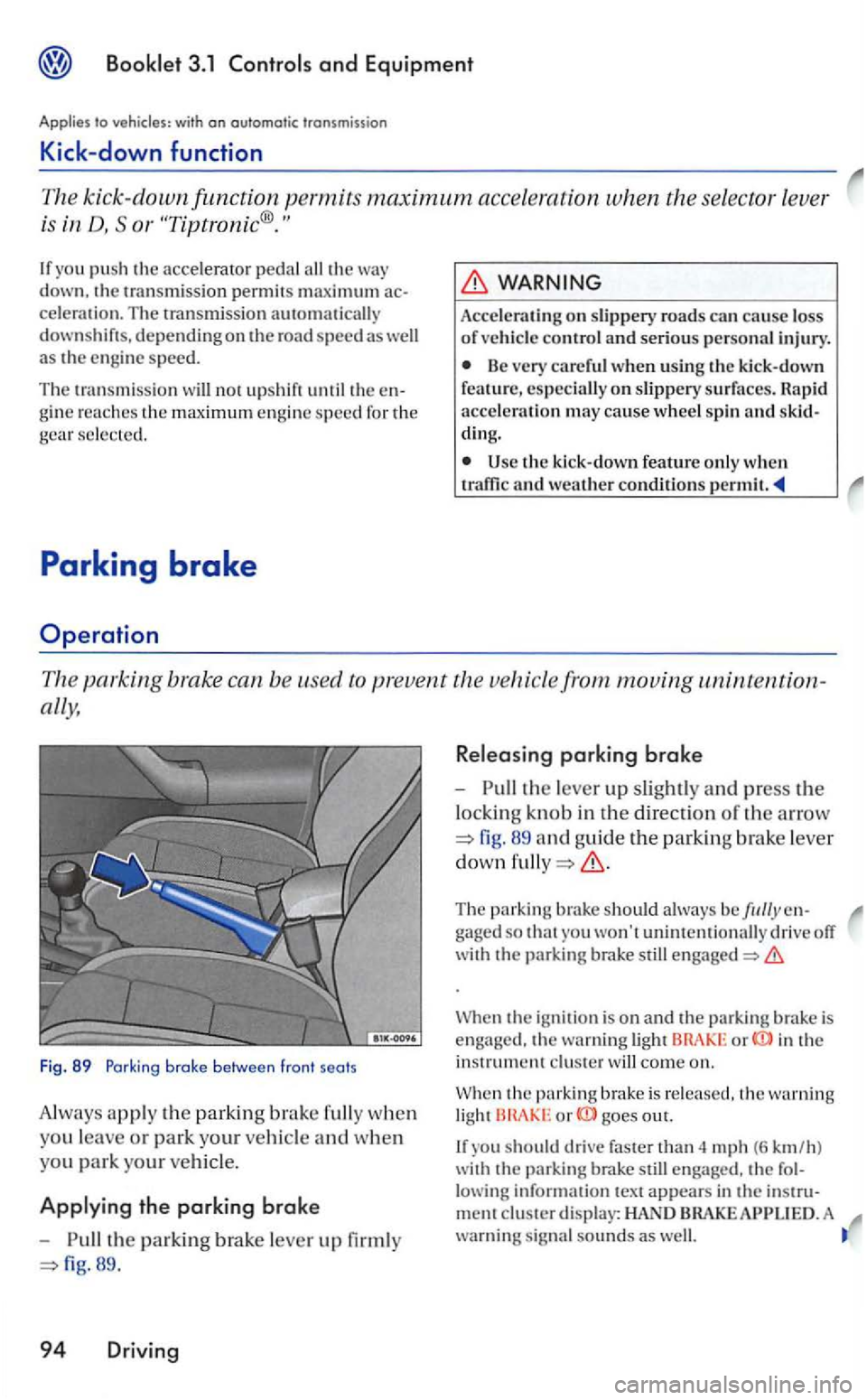
Booklet 3. 1 Controls and Equipment
Applies to v ehicle s: with on automatic trans m iss io n
Kick -down function
The kick-down funct ion permits maximu m acce leration when the selecto r lever
i s
g in e reac hes th e maximum engine speed for the gear sele c ted.
Parking brake
Operation
Accelcrat ing on slippery roads can cau se loss of ve hicl e contro l a n d serio u s personal inj u ry.
Be very care ful when using the kick-down feature, especia lly on sli ppery surfaces. Ra pid accele ra ti on m ay cause wheel spin and ding.
The parkin g brake can b e
the parking
and when
yo u park your
Applying th e parking broke
th e parking brake
89 .
94 Dri ving R
e
leasing parking broke
th e up and press the
kn ob in the d irect ion of th e a rrow
89 and guide the park in g brake
down
Th e brake should always be you wo n't unintentionally drive off
wi th the parkin g brake still
\Vhe n th e ignition is on and th e parking brak e is the wa rnin g light or in the
in strume nt clu ste r w ill come on.
or goes out.
If sh o uld drive fas ter th an 4 mph (6 km /h )
wi th th e parking brake still enga ged, the fol-
lowin g inform ation tex t appears in the m ent cluste r d is pla y: BRAKE A warning signal sounds as well.
Page 282 of 444
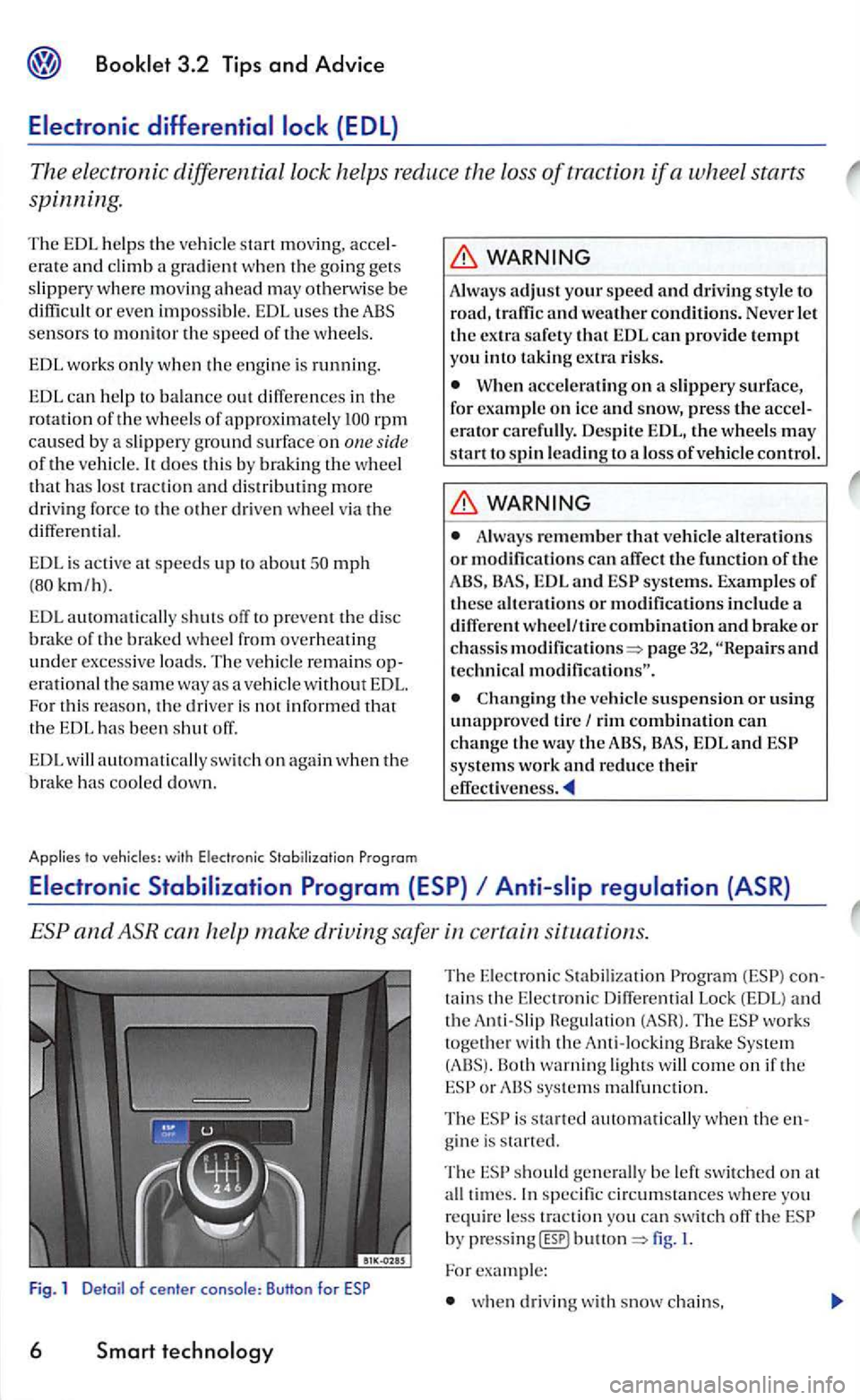
does th is by braking the whee l that h as lo st trac tion an d dis tributing more
driv ing force to the other driven wheel via the differen tial.
EDL i s active at speed s up to about mph
not that the EDL has been shut off.
EDL wi
ll automatically switch on again when the brake
Always adjust your speed and driving style to
road,
When accelerating on a slippery surface,
for example on ice and snow, press the accelerator carefully_ Despit e EDL, the wheels m ay
start t o spin leading to a loss of vehicle control.
Always remember that vehicle alterations or modifications can affect the function ofthe EDL and
page 32, and te chnical m odifications".
Changing the vehicl e s uspension or using unapproved tire rim combination can
change the way the EDL and systems work and reduce their e ff ectiveness_
6 Smart
The E lectronic Stabilization con
tai ns the E lectronic Differential Lock (EDL) and the Anti- S lip Regulation (ASR). The
or sy s te m s malfunction.
The is sta rted automatically when the engine is started.
The should generall y be left switched on at
all times. In specific circumstances where yo u
requ ire less by l.
For exampl e:
whe n driv ing w ith snow chains,
Page 287 of 444
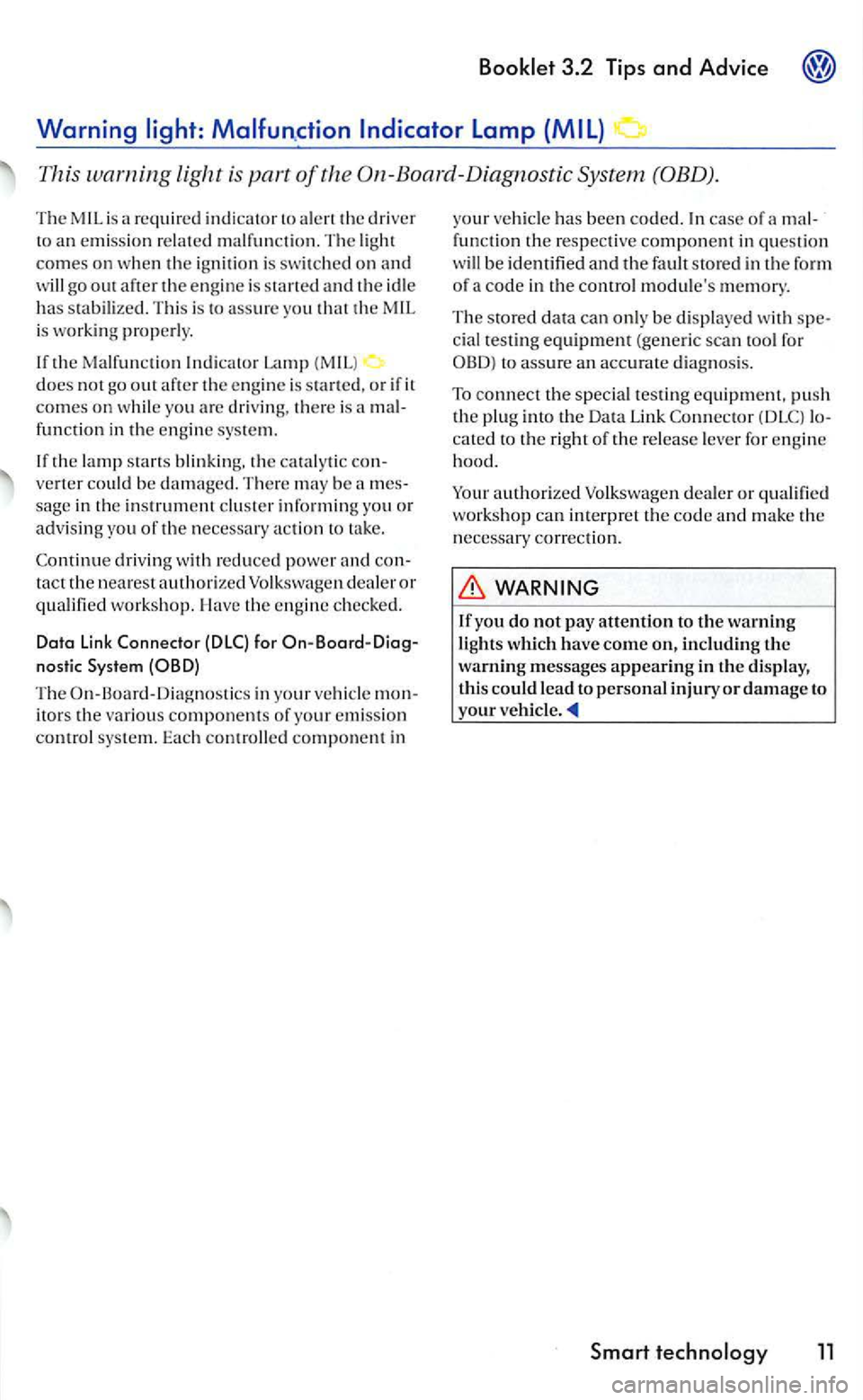
3.2 Tips and Advice
This warning light is part of the On-Board-Diagno stic System
The MIL is a required indicator
assure you that th e MIL is workin g properly.
If the Malfun ctio n (MIL )
does n o t go out after th e eng in e is s tarted, or if it comes on w hil e yo u are driv ing, th ere is a mal
function in the engine sys te m.
If
the lamp starts blinkin g. th e catal ytic converter could be damaged . T he re m ay be sag e in the in strument clu ste r informing yo u or
advis in g you of the necessa ry action to take.
(DLC) for On-Board-Diag
nostic
The O n-Board-Diagnost ics in mon
itor s the vario us components of your e mission
control system. Each controlled component in y
our ve
hicl e has been coded. In case of functio n the respective component in questio n
will be identi fied and the fault stored in the form of a code in the control module's memory.
The stored data can only be d isplaye d wit h spe
cial testing equipment (generic scan tool for di agnosis.
To c
onnect the speci al tes ting equipmen t, push the p lug into th e Da ta Link locate d to the rig ht of the release for engine
h oo d.
Your
authorize d Volkswagen dealer or quali fied
wo rkshop can interpret the code and m ake the ne cessar y correction.
you do not pay attention to the warning
lights whi c h have come on, including th e warning messages appearing in the display , this could lead to pers o n al injury or damage to your ve hicl e.
Smart
Page 288 of 444
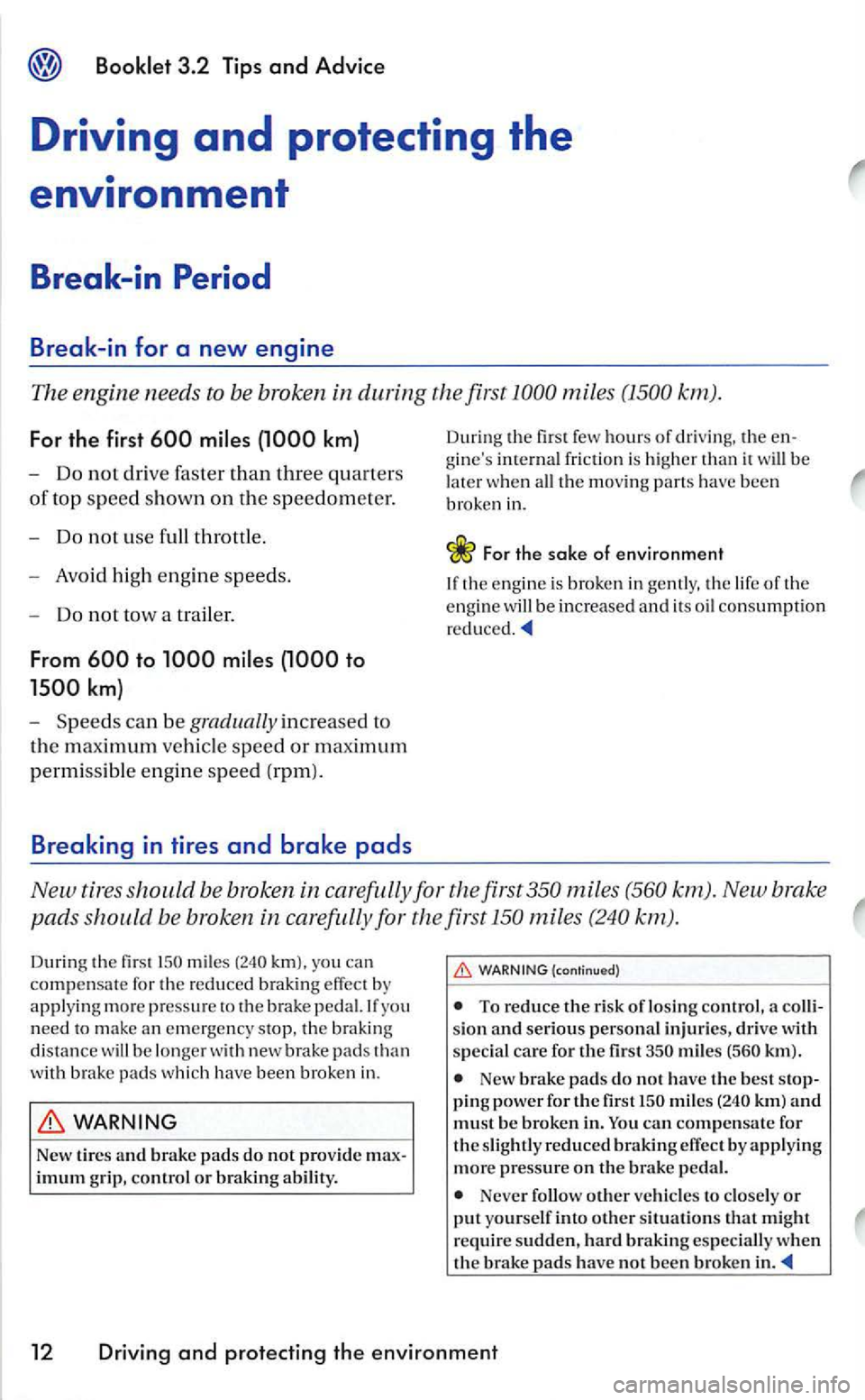
miles
can b e gradually in creased to
th e maximum vehicl e s
peed or maximum
permissibl e engin e speed (rpm ).
Breaking in tires and brake pads
Durin g the fir st few h o u rs of dri ving, the g ine 's inte rnal fric tion is hi gher than it will be
l a te r w he n a ll th e m ovin g part s have been bro ke n in.
For the sake of environment
th e eng in e is bro ke n in gentl y, the lif e of the engine will be in creased and it s oil co nsumption
New tires should be broken in carefull y for the fir st miles (560 km). New brake
pads b e broken in carefu lly for the first miles (240 km).
Durin g th e fir st miles km l. you can
c ompe nsate for the reduced brak ing effect by apply in g m ore press ure th e brake pedal.l fyo u
need to make a n em ergency slOp, the brak ing
di sta nce will b e longe r w ith new brake pads than
wit h brake pads wh ic h have been b roke n in.
WARNING
New tires and brake pads do not provide imum gri p, control o r braking
(cont;n ued)
To reduce the ri sk of losing a
miles
New brake pads do not have th e best pin g power for the fir st km) and must be broken in. can compe nsate for the s lightly reduced braking effect b y applying more pressure on the brake pedal.
N eve r follow other vehicles to clos ely or put yours elf into other situati on s that might require sudden, h a rd braking especially when the brake pads have not been broke n in.
12 Driving and protecting the environment
Page 289 of 444
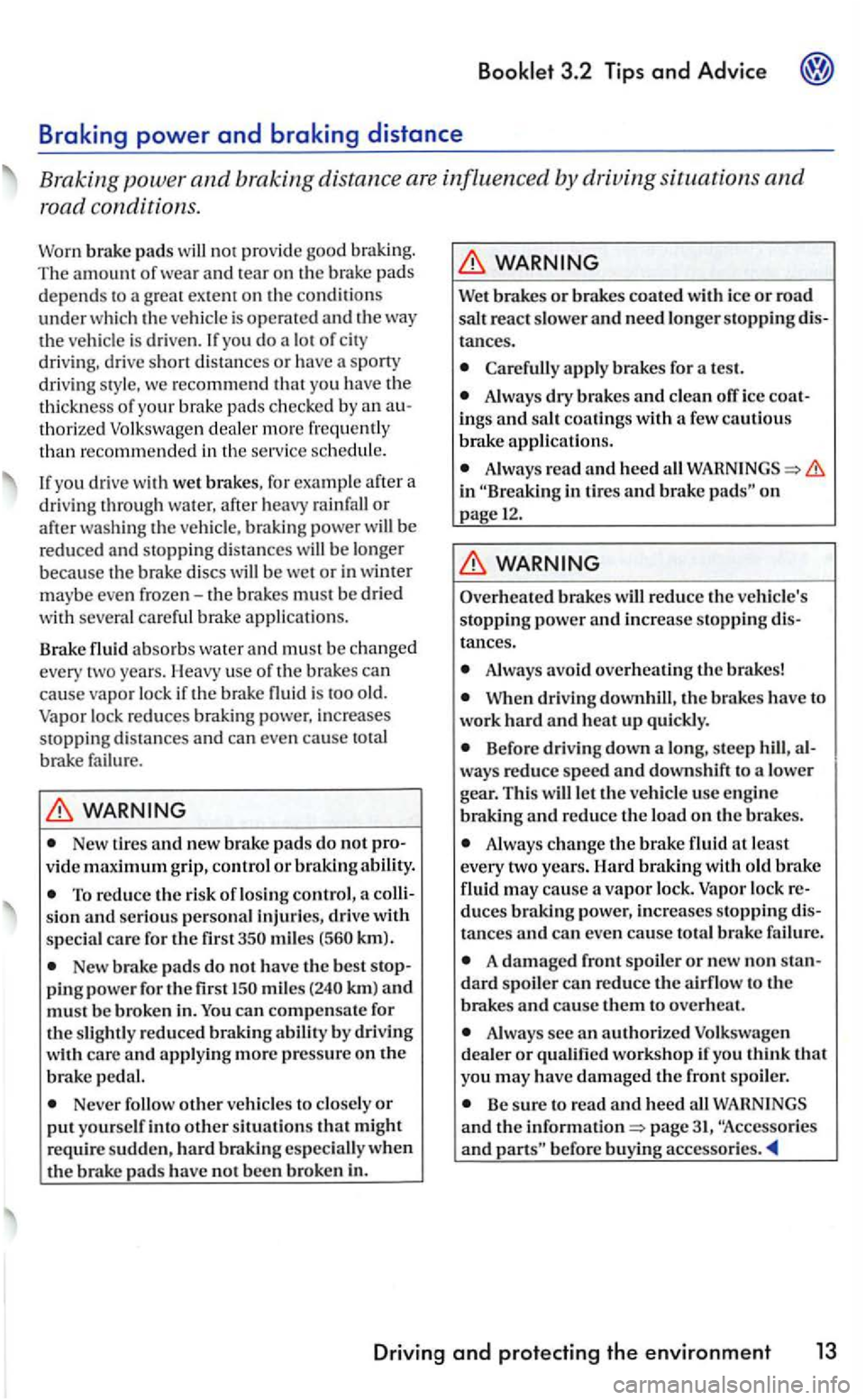
Booklet 3 .2 Tips and Advic e
recommend that you have the
thi ckne ss of your brake pads checked by an au
t horized Vol kswagen dealer mo re fre quent ly
t h an recommende d in the serv ice sched ule.
you drive with wet brakes, for example afte r a
dri ving through water, after heavy rainfall or after washing the ve hicle, braking power be
reduced and s to ppin g distances will be longer
because the brake discs will be we t or in winter mayb e eve n frozen-the brakes must be dried
with several ca re ful brak e applicatio ns.
Brak e fluid absor bs water
and must be changed
every two years. Heavy use of the brakes can cause vapor lock if the brake fluid is too old.
Vapor lock redu ces braking power, increases
stopping distances and ca n even cause total
brake failure.
New tires and new bra ke pads do no t pro
v id e m aximum gri p, control o r b raking abil ity.
To red uce the risk of l osi ng control, a s io n an d se rio us perso nal injuries, drive with
specia l ca re for the first 350 miles (560 km).
New brake pads do not have th e best sto p
ping power for the fir st ISO mile s (240 km ) and
m ust be b roken in. can compensate for the slightly reduced braki ng abil ity by dri ving care and applyin g more pressure on th e
brake pedal.
Never follow oth e r veh icles to close ly or
p u t you rse lf in to other s ituations th at might
requ ire su d den , hard bra king especially when the brake pads have not been broken in.
apply brakes for a test.
Always dry brakes and clea n off icc coat
i ngs an d salt coatings with a few cautious brake applications.
A lways read and heed in in tire s and brake on page 12.
Always avoid overheati ng the brakes!
When driving downhill, t11 e brakes have to
work har d and h eat up quickly.
Before driving down a lo ng, steep hill, al
ways reduce speed and downshift to a lower
gear. This will let the vehicle usc engine
Always ch ange th e brake fluid at l east
every two years. Hard braki ng wi th o ld flui d may cause a va po r lock . Vapor loc k duces powe r, inc reases stoppin g di stan ces and can even cause tota l b rak e failure.
A damaged front spoiler or n ew non standard spoiler can reduce t h e airflow to th e
brakes and cause them to ove rh eat.
Always see an authorized Volkswag en
dealer or qualified workshop
Be sure to re ad and heed all and th e page
Driving and protecting the environm ent 13
Page 290 of 444
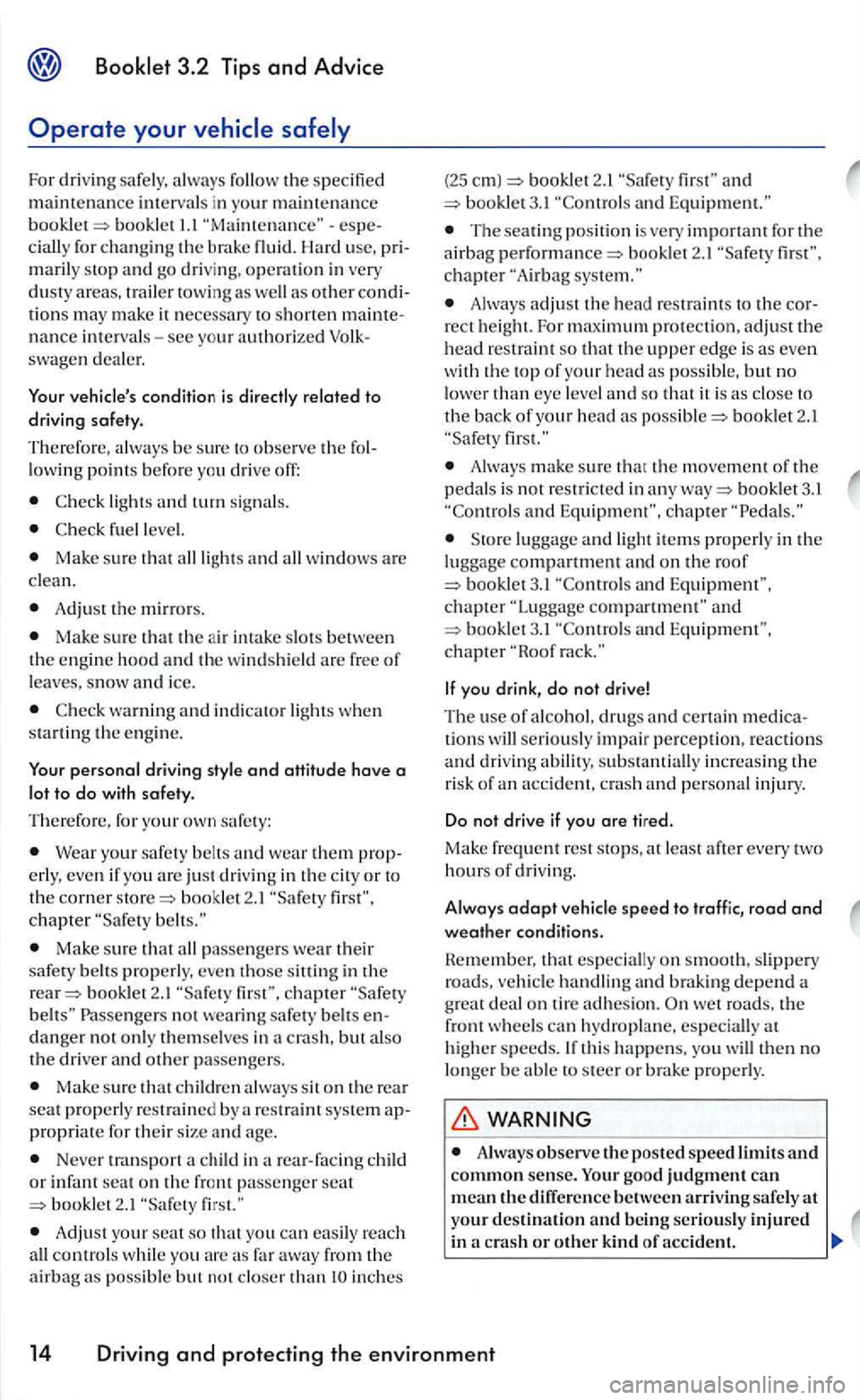
For dri ving safely. always follow the specified
maintenance int erva ls in your mainte na nce booklet 1.1 ciall y for changin g the brake fluid. Hard u se, maril y stop and go driv ing, o p eratio n in very dusty area s. trailer towing as well as other tions may make it necessary to short en nance in te rvals-see your a u th orize d swage n dealer.
Your
l ow ing po int s befo re yo u drive off:
lights and turn signal s.
Make sur e that all ligh ts and all windows are
clea n.
Adjust the mirro rs.
Make sure th at the a ir intake slots between the e ngin e hoo d and the w in d shi eld are free of leaves . s n ow and ice.
wa rnin g and indicato r light s whe n
s ta rti ng the e ng in e.
Your personal driving styl e and attitude have a
lot
to do with safety.
Th eref ore, for yo
ur ow n safety:
Wear your safety belts and wear the m
book let 2.1 chapter
Make sure that all passenge rs their safe ty be lls properly. eve n those sitting in the book le t2.1 chapter Passengers not wear ing safety bells
Make sure that chil dren always sit on the rea r seat properly restrain ed by
Neve r transport chil d in a r ear-faci ng c hild or infant seat on the fron t passe nger seat booklet2.1
Adjust you r seat that yo u can easily reach
all control s while yo u are as far away from the airbag as pos sibl e but not close r than
bookle t2.1 and bookle t3. 1
The seatin g position is ve ry important for th e
a ir bag book let2.1 chapter" Air bag
Always adjust the head rest ra int s to the rect heig ht. For maximum pro tection. adjust the
head restrai nt so the upper e d ge is as eve n
w ith the top of your head a s pos sibl e, but no lower than eye level and so that it is as close th e back of your head booklet 2.1
Always make s ure that th e movem ent of the
p ed als is not re stricted in any booklet 3.1 Equipment",
Sto re lu ggage and light it em s properly in the
lu ggage compartment and on th e roof bookle t3. 1 and Luggag e compartment " and book let3.1 and Equipment", chapte r " Roof
If you drink, do not drive!
The use of alco hol. drugs and certai n tions will seriou sly impa ir percepti on , reac tio ns and dri ving ability, substantially in creasin g the risk of an acc ident, cras h and persona l injury.
Do not driv e if you are tired.
Make frequ ent rest sto ps, least afte r every two hours of dri ving.
Always
adapt vehicle speed to traffic, rood and
weather conditions.
R e
member, that especially on sm oot h. slipp ery
roa ds, ve hicl e ha ndl ing and brak ing depend a
g reat deal o n tire adhes ion. wet roads, the
f ront w heels can h ydropla ne, especi ally at
hi ghe r speeds. th is happen s, yo u will then no
lon ger be abl e to steer or brake properly.
Alwa ys observe the p osted speed limits and common sense. good judg m ent can mean the diff ere nce b e tween arriving safely at your d estination and being seriou sly injured in a cras h or othe r kind of accident.
14 Driving and protecting the environment